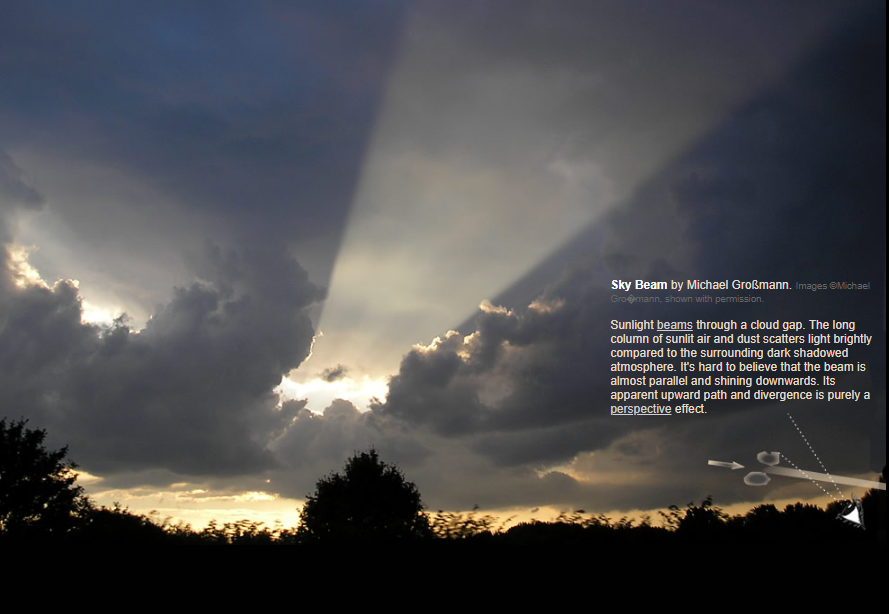Sky Beam
Sky Beam: A Phenomenon of Light and Perspective
Have you ever witnessed a mesmerizing sight where sunlight breaks through a gap in the clouds, creating a radiant beam that cuts through the sky? This awe-inspiring phenomenon, known as a "Sky Beam," captivates our imagination and leaves us in wonder. In this article, we will explore the science behind this ethereal display and unravel the secrets hidden within its mesmerizing glow.
When sunlight encounters a gap in the cloud cover, a long column of air and dust becomes illuminated, scattering light with remarkable brightness. In contrast to the surrounding shadowed atmosphere, the sunlit air appears to shine brilliantly. However, what may seem like a beam of light shooting upwards is actually a trick of perspective. The beam is almost parallel to the ground and is, in fact, shining downwards.
To understand the formation of a Sky Beam, we must delve into the fascinating world of atmospheric optics. The scattering of light by particles in the air plays a crucial role in creating this enchanting spectacle. As sunlight enters the atmosphere, it interacts with tiny particles such as dust, water droplets, and ice crystals suspended in the air. These particles scatter the light in different directions, causing it to disperse and create various optical phenomena.
The intensity of the scattering process is influenced by several factors, including the size and composition of the particles, as well as the wavelength of light. In the case of a Sky Beam, the column of air and dust within the beam acts as an ideal medium for scattering. The sunlight is scattered predominantly in a forward direction, resulting in a concentrated beam of light that appears brighter than its surroundings.
Although the Sky Beam may appear to defy gravity by reaching upwards, it is important to remember that this is merely an optical illusion. The apparent upward path and divergence of the beam are solely products of our perspective. In reality, the beam is parallel to the ground and shines downwards, giving it a vertical appearance from our vantage point.
The phenomenon of a Sky Beam is not limited to a single type of cloud formation. It can occur when sunlight interacts with various cloud types, such as cumulus clouds, stratocumulus clouds, or even towering cumulonimbus clouds. Each cloud type creates its own unique display of the Sky Beam, adding to the diversity and beauty of this natural wonder.
The size and shape of the gap in the cloud cover also influence the appearance of the Sky Beam. A narrower gap may result in a more concentrated and well-defined beam, while a wider gap can lead to a broader and diffused beam. The interplay between the cloud gap, the angle of the sunlight, and the scattering properties of the particles all contribute to the final visual effect observed by the beholder.
As we marvel at the breathtaking sight of a Sky Beam, we are reminded of the intricate interplay between light, particles, and perspective in our atmosphere. This captivating phenomenon serves as a reminder of the wonders that surround us and the scientific principles that govern our world. So, the next time you find yourself gazing at the sky, keep an eye out for this celestial spectacle and allow yourself to be enchanted by the magic of a Sky Beam.

Sky Beam by Michael Großmann. Images ©Michael Gro�mann, shown with permission.
Sunlight beams through a cloud gap. The long column of sunlit air and dust scatters light brightly compared to the surrounding dark shadowed atmosphere. It's hard to believe that the beam is almost parallel and shining downwards. Its apparent upward path and divergence is purely a perspective effect.
Note: this article has been automatically converted from the old site and may not appear as intended. You can find the original article here.
Reference Atmospheric Optics
If you use any of the definitions, information, or data presented on Atmospheric Optics, please copy the link or reference below to properly credit us as the reference source. Thank you!
-
<a href="https://atoptics.co.uk/blog/sky-beam/">Sky Beam</a>
-
"Sky Beam". Atmospheric Optics. Accessed on November 26, 2024. https://atoptics.co.uk/blog/sky-beam/.
-
"Sky Beam". Atmospheric Optics, https://atoptics.co.uk/blog/sky-beam/. Accessed 26 November, 2024
-
Sky Beam. Atmospheric Optics. Retrieved from https://atoptics.co.uk/blog/sky-beam/.